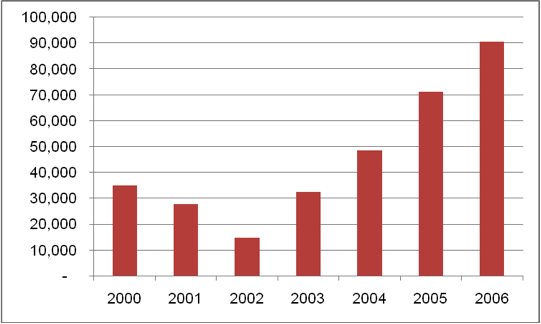IER analyzes energy ‘plan’ proposed by the Speaker of the House

On Saturday, August 16, the Speaker of the House delivered a radio address focused on energy issues. The following analyzes some of the claims and proposal outlined by the Speaker in that address.
THE SPEAKER: “Over the past few months alone, Republicans have voted down our efforts to expand domestic drilling, opposed clean energy alternatives, and rejected requiring oil companies to produce from the public lands they already control. President Bush even refused our request to suspend buying oil at record prices for the federal stockpile until we passed a law, and the price fell by over $20 a barrel.”
THE FACTS: The House has yet to consider legislation that would “expand” domestic production to federal areas that are currently off-limits. No such legislation has been crafted or submitted for consideration by the Speaker. “Requiring oil companies to produce from the public lands they already control” is already public law, as outlined in the Mineral Leasing Act and the Outer Continental Shelf Lands Act.
The Speaker’s claim relates to a “68 million acres” talking point, which has been summarily dismissed by virtually every honest observer of the energy debate. And although President Bush agreed to halt additions to the SPR on May 20 of this year, the SPR stockpile has continually grown throughout the summer because of pre-existing contracts. The SPR contains roughly 4 million barrels more today than it did when President Bush signed the legislation halting SPR additions.[1] If Speaker Pelosi wants to take credit for falling oil prices because of the change in SPR policy, she will have to admit that oil traders react to news about future oil availability.
If traders push down the price of oil today because of a change in SPR purchasing policies that still have yet to kick in, then they can also react to news that offshore drilling has been legalized. On July 14, the day President Bush tore up the executive moratorium on OCS development oil prices started at an all-time high of $147.27. Since then, prices have dropped 24%, to about $113 per barrel. That was a signal to markets – speculators stopped speculating in oil and started speculating in dollars, having faith that America would start to fight back. If Congress lets its own Oil Embargo expire October 1, maybe we can peel another $34 off the price of oil.
THE SPEAKER: “It is time we revisited the relationship between American taxpayers and consumers who own the valuable oil reserves and Big Oil, who profit from them.”
THE FACTS: We at IER would like to revisit this relationship too, as the Speaker has omitted some critical information. Taxpayers – not the government – own the federal lands and the massive energy resources that lie beneath them. When energy companies produce energy on federal lands, the taxpayers benefit in a number of ways.
Energy production creates jobs, stimulates the economy, and helps create the supplies we need to meet demand to lower consumer prices. In addition, energy production creates a “windfall” of new federal revenue (so Washington politicians might be less inclined to generate revenue by raising taxes on families).
In addition to paying massive income tax bills, energy companies are required to pay “royalties” and “bonus bids” for the right to explore for and produce oil and gas on federal lands. The taxpayer’s total return from royalty payments was $4.95 billion in fiscal year 2000, $10.7 billion in fiscal year 2006, and is projected to exceed $20 billion for fiscal year 2008. Conversely, when it is illegal to produce taxpayer-owned energy resources on our own federal lands, our dependence on foreign sources increases, prices go through the roof, our economy suffers, and the “Really Big Oil Companies” owned by the governments of Saudi Arabia, Nigeria, Venezuela and the like reap enormous profits.
THE SPEAKER: “The Republican ‘drill only’ plan would lower oil prices by only 2 cents a gallon over ten years.”
THE FACTS: This greatly mischaracterizes the plan to which the Speaker refers. Although she gives no source, Speaker Pelosi is presumably referring to an EIA report that is several years old, and which assumed that the price of oil in 2030 would be $80 per barrel including inflation ($50 in today’s dollars).
IER covered this issue in full here.
If oil prices should remain higher than these optimistic forecasts assume, then the price impact of opening just ANWR would be much higher than the “2 cents a gallon” figure. EIA itself confirmed this recently, when it sent a letter to Congress detailing that if 1 million barrels of oil showed up in markets tomorrow, world oil prices would drop $20, meaning prices at the pump would fall 50 cents a gallon. We all observed that since Bush’s announcement lifting the executive moratorium, oil prices have dropped $34, or 81 cents per gallon. No one knows exactly how much prices would drop if Congress follows suit and allows its moratorium to expire, but the impact would surely be more than “2 cents a gallon.”
THE SPEAKER: “Instead, releasing some oil from the government stockpile will reduce consumer prices in ten days, not ten years.”
THE FACTS: As of early August, there were 707 million barrels in the SPR,[2] about 73 days’ worth of net crude imports.[3] It is true that releasing oil from the SPR would bring immediate relief at the pump; that’s what happens when supply increases. However, especially with the outbreak of war between Russia and Georgia, and the continued tensions with Iran, it is imprudent to reduce the SPR’s cushion by a week, as Speaker Pelosi recommends. Rather than tap into the 700 million barrels in the SPR, it makes much more sense to tap into the 10 billion barrels in ANWR, the 86 billion barrels in the OCS, and the 800 billion barrels of shale oil resources on U.S. taxpayer owned land. Giving the green light to produce these resources would bring immediate price relief, as producers with excess capacity (such as Saudi Arabia) increased their output in the near term, knowing they will face more competition in the future from U.S. producers.[4] This is exactly what has happened over the last few months: As U.S. politicians began calling for more drilling, Saudi Arabia reversed its earlier refusal to pump more. Oil prices fell more than $15 in the first week that President Bush lifted the executive ban. If the Congressional ban expires on September 30, we can expect further—and immediate—price reductions.
THE SPEAKER: “[Our plan] will increase the use of natural gas, which is abundant, clean, and cheap.” THE
FACTS: The problem with Speaker Pelosi’s suggestion is that the abundant and clean natural gas supplies must be reached by drilling for them. It would be hard to imagine a more counterproductive energy policy than one that maintains prohibitions on drilling and calls for expanding the use of natural gas at the same time.
THE SPEAKER: “Big Oil insists that despite record profits, the U.S. taxpayer must continue to subsidize their drilling. This must end.”
THE FACTS: IER covered this issue extensively here in its analysis of the similarly-challenged “Gang of Ten” energy plan. The alleged “subsidy” to which the Speaker refers is the Section 199 manufacturing deduction, which was adopted as part of the American Jobs Creation Act of 2004. This deduction was not targeted specifically for oil and gas companies, but at all American manufacturers. Why? If the United States taxes companies at higher rates than other countries, the United States loses jobs and economic investment. Repealing the Section 199 deduction for oil companies will result in just that. A list of real (staggering) energy subsidies can be found here
 Figure 1: Total Wordlwide Income Tax Expense for FRS Oil and Gas Companies (millions $US, source: EIA [5])
Figure 1: Total Wordlwide Income Tax Expense for FRS Oil and Gas Companies (millions $US, source: EIA [5])If Congress has changed its mind and no longer wants to provide tax incentives to encouarge investments in manufacturing here at home, that is certainly their prerogative. But to say that major oil companies are shirking their tax obligations is simply false, as the chart to the right demonstrates.
THE SPEAKER: “And nearly 90 million acres of public land are already open for drilling, and a bipartisan majority of Congress supports telling Big Oil to ‘use it or lose it’ before getting more leases.”
THE FACTS: IER has thoroughly discredited this nonsensical assertion, as has virtually every policy expert in the field, including the International Association of Petroleum Geologists. Oil and natural gas deposits are not spread uniformly over every acre of leased land, and so naturally energy producers won’t “use” them all to the same extent, as Speaker Pelosi seems to expect. The real challenge, should the media choose to accept it, would be to find a credible expert who would confirm such a preposterous notion. The government owns a huge amount of land and offshore areas, but only leases 3% of it for energy. Ninety-seven percent is not being used because of government policies of all kinds, whether outright prohibitions or courts and regulators seeking to accommodate environmental challenges. With high oil and natural gas prices, American energy producers are eager to expand their operations, creating jobs and lowering prices in the process. In contrast to these private-sector corporations, the huge state-owned foreign energy companies benefit from continued hurdles to American competition.
Click here for a list of the “Really Big Oil” companies that benefit from the government’s refusal to use more than 3.7 percent of all federal lands for energy leasing.
** THE BOTTOM LINE **
In her national radio address, House Speaker Nancy Pelosi continues the strategy of bait and switch on energy. Realizing American voters strongly support increased domestic energy production, the Speaker has belatedly adopted the “drill here” rhetoric, while her actual behavior in Congress reflects the failed “drill nothing” energy policy long championed by opponents of domestic energy production. The American people know that the surest way to lower oil prices and reduce American economic dependence on volatile areas of the world is to allow the development of U.S. resources. The Congressional moratorium expires on September 30. At that point, unbridled market forces will do their job, with American entrepreneurs developing America’s vast energy supplies. Speaker Pelosi would to more to “help” families struggling with high energy bills by simply standing aside. [display_podcast]
Citations
1. A weekly history of SPR stocks available at: http://tonto.eia.doe.gov/dnav/pet/hist/wcsstus1w.htm. Accessed August 18, 2008.
2. SPR stock data available at: http://tonto.eia.doe.gov/dnav/pet/pet_stoc_wstk_dcu_nus_w.htm. Accessed August 18, 2008.
3. Crude import data available at: http://tonto.eia.doe.gov/dnav/pet/pet_move_wkly_dc_NUS-Z00_mbblpd_w.htm. Accessed August 18, 2008.
4. On the argument that opening up future production would bring down current prices, see the (unpublished) academic paper by Coats and Pecquet available at: http://mpra.ub.uni-muenchen.de/9543/. Also see Martin Feldstein’s July 1 Wall Street Journal op ed, available at: http://online.wsj.com/article/SB121486800837317581.html.
5. Income tax expenses obtained from EIA’s Performance Profiles Tables, Table B12, at: http://www.eia.doe.gov/emeu/perfpro/btab12.html. Accessed August 4, 2008.



